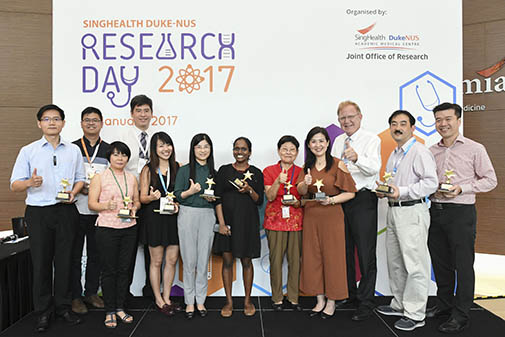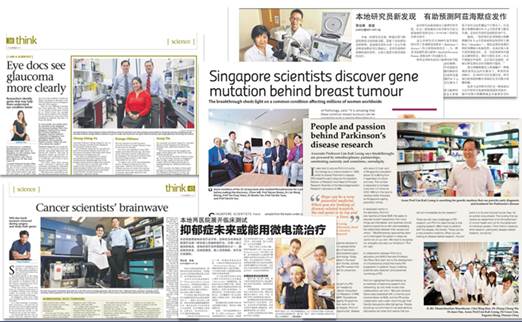The Joint Research Communications team aims to showcase our research community in meaningful and accessible ways.
What goes on behind the scenes in research? Who are the unsung heroes in the labs? The Joint Research Communications team aims to showcase our research community in meaningful and accessible ways.
For almost four years, Ng Chiat Eng, a Clinical Research Coordinator at SingHealth Polyclinics doggedly recruited participants for clinical trials from thousands of patients at two different polyclinics.
It was a tricky endeavour and rejections were common. It was also challenging for Chiat Eng, a retired nurse, to be on her feet constantly, but she never gave up. Her name may not appear in the research papers published, but these clinical trials would not have been possible without her contribution.
For her tireless enthusiasm and determination, she was conferred the "Most Caffeinated Award" in the SingHealth Duke-NUS Research Appreciation Awards 2017.

Ng Chiat Eng (5th from right) with other winners of the SingHealth Duke-NUS Research Appreciation Awards 2017
Celebrating team effort in research
The Awards honour individuals who have been nominated by their colleagues for being the "Mad Scientist", "Yoda Grant Master" or "Most Coordinated Coordinator." These titles may sound wacky, but have a serious aim – to shine the spotlight on research team members who work behind the scenes at our Academic Medical Centre (AMC).
The idea for these awards arose from a study conducted by the Joint Research Communications (JRC) team, a cross-institution workgroup that aims to advance research communications.
"Research values data and evidence. So we did our own mini-research for what was needed in research communications," said Lydia Ng, Manager, Group Communications and member of the JRC team.
For the study, the team conducted 30 in-depth interviews with researchers across domains and surveyed more than 500 clinician scientists, scientists, biostatisticians, clinical trial coordinators and research administrators. It clinched the Asia Pacific Communications Award 2015 (Evaluation & Measurement Category) for its measurement and analyses to drive communications in research.

A result of JRC's efforts: News articles shining the spotlight on the teams behind research achievements, and not only on the principal investigators.
Gaps identified through the study showed that there was almost unanimous consensus that Principal Investigators should not be the only ones getting recognised in the media and award announcements. That set the team thinking about how best to recognise the contributions of other members in research teams given the space constraints imposed by news articles, for example.
In addition to initiating the Awards, the JRC started profiling research teams and more junior scientists actively in the mass media to reflect the nature of research as a "team sport".
Bringing researchers together
The study also highlighted the need for more face-to-face networking opportunities among researchers. This prompted the first SingHealth Duke-NUS Research Day, organised in 2016.
It brought together thought leaders such as Nobel Laureates Prof Ada Yonath and Prof John Robin Warren, researchers and collaborators in the research community network and share ideas.
Acknowledging that many researchers do their magic in the labs but often, the science-speak can be too difficult for members of the public to understand, a video series, entitled 'Science in the Hospital' has been rolled out to engage stakeholders on the value of the AMC's research efforts through easy-to-understand analogies explained by researchers.
By devising different ways and ideas to 'break down' the science, the JRC team hopes to continue to showcase the AMC's research endeavours going forward.
